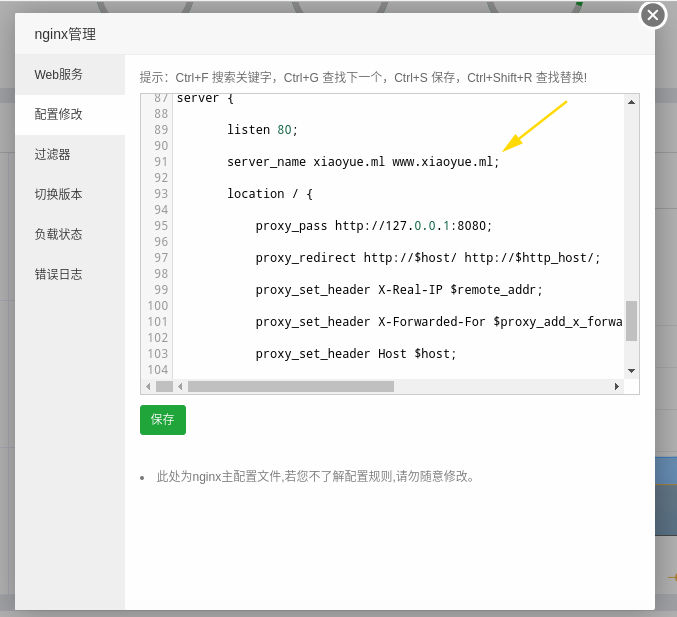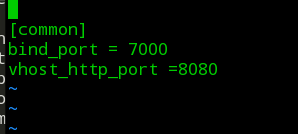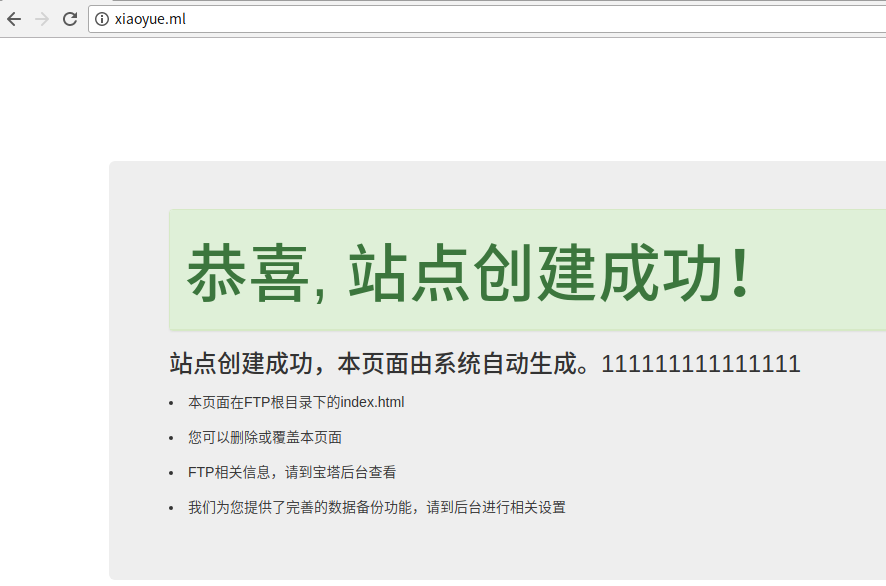 Operation and Maintenance
Operation and Maintenance
 Nginx
Nginx
 How to configure nginx to ensure that the frps server and web share port 80
How to configure nginx to ensure that the frps server and web share port 80
How to configure nginx to ensure that the frps server and web share port 80
Jun 03, 2023 am 08:19 AMFirst of all, you will have a doubt, what is frp? Simply put, frp is an intranet penetration tool. After configuring the client, you can access the intranet through the server.
Now my server has been built with nginx, and there is only one port 80. So what should I do if the frp server also wants to use port 80?
After querying, this can be achieved by using nginx's reverse proxy.
To add: frps is the server (server), frpc is the client (client).
Step one: Modify the nginx.conf configuration file in the server
Add the following parameters in http{ } in nginx.conf,
server {
listen 80;
server_name xiaoyue.ml www.xiaoyue.ml;
location / {
proxy_pass http://127.0.0.1:8080;
proxy_redirect http://$host/ http://$http_host/;
proxy_set_header x-real-ip $remote_addr;
proxy_set_header x-forwarded-for $proxy_add_x_forwarded_for;
proxy_set_header host $host;
}
} As shown below, save the settings and restart nginx

Step 2: Modify the frp server configuration file
Since the reverse proxy has reached port 8080, the configuration file of the frp server also needs to be set
vhost_http_port = port 8080 in the frps.ini configuration file

The third step: Modify the frp client configuration file
The first step is configuring: server_name xiaoyue.ml www.xiaoyue.ml; Fill in the corresponding domain name here.
also supports pan-parsing, for example: server_name *.xiaoyue.ml; the domain name needs to be pan-parsed at the same time.
So how to modify frpc.ini, it’s very simple
Configure the corresponding domain name in the corresponding penetration service configuration, custom_domains = xiaoyue.ml

Step 4:
Restart frps on the server, start frpc on the local computer, and you can pass 80 in the browser The port directly accesses xiaoyue.ml.

Additional 1:
xiaoyue.ml is parsed to my server, and this website is built in the LAN in my own computer.
That is to say, first make sure that you access 127.0.0.1 on your computer and there is content.
Additional 2:
The reverse proxy in the first step can also be done like this
Pagoda background
1) Website -->Add a site, enter your domain name
For example, enter the added domain name xiaoyue.ml Submit
2) Click Settings-->Reverse proxy
Target Fill in http://127.0.0.1:8080 in the url, please do not enter the wrong
Choose to enable reverse proxy
ps: Are you a little confused? . .
In fact, the core of this article is just one step, which is to reverse proxy to xiaoyue.ml:8080 port when you visit xiaoyue.ml (by default, we access the website through port 80).
Then what’s the point of doing this? I just want to access the website directly through the domain name instead of accessing the website through the domain name:port number.
The above is the detailed content of How to configure nginx to ensure that the frps server and web share port 80. For more information, please follow other related articles on the PHP Chinese website!

Hot AI Tools

Undress AI Tool
Undress images for free

Undresser.AI Undress
AI-powered app for creating realistic nude photos

AI Clothes Remover
Online AI tool for removing clothes from photos.

Clothoff.io
AI clothes remover

Video Face Swap
Swap faces in any video effortlessly with our completely free AI face swap tool!

Hot Article

Hot Tools

Notepad++7.3.1
Easy-to-use and free code editor

SublimeText3 Chinese version
Chinese version, very easy to use

Zend Studio 13.0.1
Powerful PHP integrated development environment

Dreamweaver CS6
Visual web development tools

SublimeText3 Mac version
God-level code editing software (SublimeText3)

Hot Topics
 How to start containers by docker
Apr 15, 2025 pm 12:27 PM
How to start containers by docker
Apr 15, 2025 pm 12:27 PM
Docker container startup steps: Pull the container image: Run "docker pull [mirror name]". Create a container: Use "docker create [options] [mirror name] [commands and parameters]". Start the container: Execute "docker start [Container name or ID]". Check container status: Verify that the container is running with "docker ps".
 How to check the name of the docker container
Apr 15, 2025 pm 12:21 PM
How to check the name of the docker container
Apr 15, 2025 pm 12:21 PM
You can query the Docker container name by following the steps: List all containers (docker ps). Filter the container list (using the grep command). Gets the container name (located in the "NAMES" column).
 How to check whether nginx is started
Apr 14, 2025 pm 01:03 PM
How to check whether nginx is started
Apr 14, 2025 pm 01:03 PM
How to confirm whether Nginx is started: 1. Use the command line: systemctl status nginx (Linux/Unix), netstat -ano | findstr 80 (Windows); 2. Check whether port 80 is open; 3. Check the Nginx startup message in the system log; 4. Use third-party tools, such as Nagios, Zabbix, and Icinga.
 How to create containers for docker
Apr 15, 2025 pm 12:18 PM
How to create containers for docker
Apr 15, 2025 pm 12:18 PM
Create a container in Docker: 1. Pull the image: docker pull [mirror name] 2. Create a container: docker run [Options] [mirror name] [Command] 3. Start the container: docker start [Container name]
 How to start nginx
Apr 14, 2025 pm 01:06 PM
How to start nginx
Apr 14, 2025 pm 01:06 PM
Question: How to start Nginx? Answer: Install Nginx Startup Nginx Verification Nginx Is Nginx Started Explore other startup options Automatically start Nginx
 Choosing Between NGINX and Apache: The Right Fit for Your Needs
Apr 15, 2025 am 12:04 AM
Choosing Between NGINX and Apache: The Right Fit for Your Needs
Apr 15, 2025 am 12:04 AM
NGINX and Apache have their own advantages and disadvantages and are suitable for different scenarios. 1.NGINX is suitable for high concurrency and low resource consumption scenarios. 2. Apache is suitable for scenarios where complex configurations and rich modules are required. By comparing their core features, performance differences, and best practices, you can help you choose the server software that best suits your needs.
 PHPStorm performance optimization method under centos
Apr 14, 2025 pm 05:30 PM
PHPStorm performance optimization method under centos
Apr 14, 2025 pm 05:30 PM
Practical Tips for Improving PhpStorm Performance in CentOS Systems This article provides a variety of methods to help you optimize the performance of PhpStorm in CentOS systems and thus improve development efficiency. Before implementing any optimization measures, be sure to back up important data and verify the results in the test environment. 1. System-level optimization and streamline system services: Disable unnecessary system services and daemons to reduce system resource usage. Interfaceless Mode: Switching to interfaceless mode can significantly save resources if you do not need a graphical interface. Uninstall redundant software: Remove software packages and services that are no longer in use and free up system resources. 2. PHP configuration optimization enable OPcache: install and configure OPcache extensions to display
 NGINX vs. Apache: Performance, Scalability, and Efficiency
Apr 19, 2025 am 12:05 AM
NGINX vs. Apache: Performance, Scalability, and Efficiency
Apr 19, 2025 am 12:05 AM
NGINX and Apache are both powerful web servers, each with unique advantages and disadvantages in terms of performance, scalability and efficiency. 1) NGINX performs well when handling static content and reverse proxying, suitable for high concurrency scenarios. 2) Apache performs better when processing dynamic content and is suitable for projects that require rich module support. The selection of a server should be decided based on project requirements and scenarios.





